Method for multiple access interference suppression, and receiver
a technology of interference suppression and received signals, applied in the direction of transmission, electrical equipment, etc., can solve the problems of multiple access interference (mai), the complexity of the receiver increases exponentially with the number of users, and the signals transmitted by the different users interfere with each other in the receiver, so as to simplify the computing and the structure of interference suppression implementation, reduce the number of filtering operations, and reduce the effect of heavy multiplication operations
- Summary
- Abstract
- Description
- Claims
- Application Information
AI Technical Summary
Benefits of technology
Problems solved by technology
Method used
Image
Examples
Embodiment Construction
[0020]The interference suppression solutions presented are applicable to telecommunication systems. One such telecommunication system is a WCDMA radio system employing wideband spread spectrum data transmission. In the following, the implementations will be described by using the GPRS and UMTS radio systems as examples, without, however, any restriction thereto, as is apparent to a person skilled in the art.
[0021]Let us first study FIG. 1 illustrating the structure of radio systems in a simplified manner at network element level. The structure and functions of network elements are described on a quite general level, since they are generally known per se. A core network CN 100 describes the radio-independent layer of a telecommunication system. A first radio system, i.e. a radio access network UTRAN 130 and a second radio system, i.e. a base station system BSS 160 illustrate radio systems. The term UTRAN means UMTS (Universal Mobile Telephone System) Terrestrial Radio Access Network,...
PUM
 Login to View More
Login to View More Abstract
Description
Claims
Application Information
 Login to View More
Login to View More - R&D
- Intellectual Property
- Life Sciences
- Materials
- Tech Scout
- Unparalleled Data Quality
- Higher Quality Content
- 60% Fewer Hallucinations
Browse by: Latest US Patents, China's latest patents, Technical Efficacy Thesaurus, Application Domain, Technology Topic, Popular Technical Reports.
© 2025 PatSnap. All rights reserved.Legal|Privacy policy|Modern Slavery Act Transparency Statement|Sitemap|About US| Contact US: help@patsnap.com



